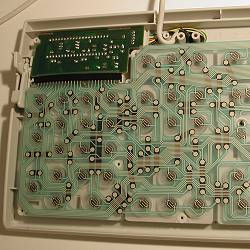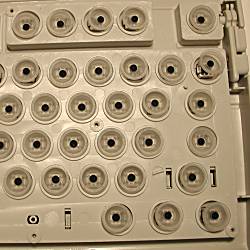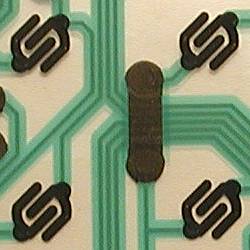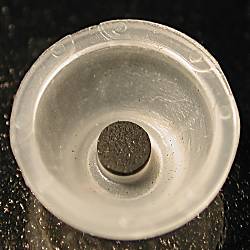[ The PC Guide | Systems and Components Reference Guide | Keyboards | Keyboard Construction and Operation | Keyswitches ]
Rubber Dome (Carbon-Contact) Keyswitches
The rubber-dome keyswitch design uses the same basic principle of operation as the foam and foil keyswitch, but significantly improves upon the latter's weaknesses by using better materials to make and break contact.
As with the foam and foil design, a circuit board with pairs of electrical contacts is used. In this technology, however, instead of a plunger pushing a foam pad onto the contacts, each keyswitch is fitted with a rubber dome, or hood, which is placed open-end down on the surface of the circuit board, the way you might place a bottle cap on a table with the flat surface up. On the underside of the rubber dome, at the top, is a small pad or "button" of carbon.
When the plunger is pressed by the keycap, the rubber dome is pushed down until it passes its "bending point", at which point it temporarily "collapses". When this happens, the carbon button connects the pads on the circuit board and the circuit is closed, registering the keypress. When the plunger is released, the rubber naturally reforms itself, forcing the key back to its normal position.
This technology has become the most popular in the keyboard world due to the elegance of its design. The natural "springiness" of the rubber means that no metal springs are required for each key, and the rubber itself is inexpensive, allowing cost to be greatly reduced. The "mush" problem with foam and foil is also much reduced, because the action of the rubber boot snapping back and forth provides tactile feel and a slight sound as well, and there is no soft foam. Of course, this depends on the exact size and shape of the domes, and the type of rubber used. It's still possible to get quite a "foamy feel" from a rubber dome keyboard if it is poorly implemented.
|
Top Left: a rubber-dome keyboard with
the base removed. You can see the rubber |
In terms of feel, most typists find rubber dome designs good, or at least acceptable. They don't have as strong a feel or loud a sound as the purely mechanical or capacitive designs, which some still prefer (of course, the feedback on these types of keyboards is from special circuitry added to create it). You could consider rubber-dome keyboards as "middle of the road" in terms of tangible feedback, audibility and feel overall.
When it comes to durability, this technology is also fairly "middle of the pack". There are still occasionally corrosion and dirt problems, but less so than with foam and foil designs, since the small carbon buttons are less susceptible to contamination. The rubber hoods will last for millions of keystrokes, but this design is not considered as durable as the capacitive design, for example.
The combination of moderate feel, inexpensive construction and decent durability has caused this technology to be the most popular in the PC world at present.
![]() Next: Membrane Contact Keyswitches
Next: Membrane Contact Keyswitches
| The PC Guide
(http://www.PCGuide.com) Site Version: 2.2.0 - Version Date: April 17, 2001 © Copyright 1997-2004 Charles M. Kozierok. All Rights Reserved. |
Not responsible for any loss resulting from the use of this site. Please read the Site Guide before using this material. |



